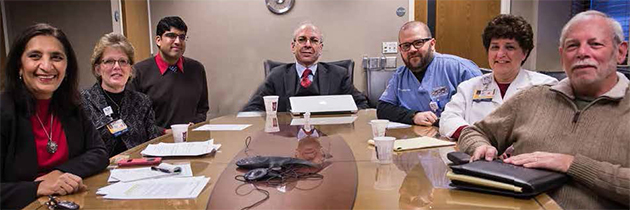A New Vision for Eye Care in India | University of Rochester School of Nursing
By Nora Hicks
Monday, March 23, 2015

Drivers of the URMC/LVPEI initiative include Barinder (Vinda) Patel, Kathy Rideout, ophthalmologist Rajeev Ramchandran, MD, MBA, Mark Taubman, Robert Dorman, Kelly Vogt, and Terry Meacham
Collaboration aims to curb blindness by educating more nurses and ophthalmic nursing assistants in ophthalmic care
India has one of the highest populations of blindness in the world. More than 20 percent of the world’s visually-impaired men, women and children reside within the country’s borders. What’s most alarming, though, is that most of these eye problems are preventable.
By far, most visual impairment in India is due to refractive errors (nearsightedness, farsightedness, presbyopia related to aging, and astigmatism) that are easily corrected with eyeglasses and contact lenses in countries like the United States. Cataracts, which also can be treated with simple surgery, are another disabling issue for many. These inequities exist because there simply aren’t enough accessible, affordable eye care specialists to meet the needs of patients, particularly those in rural, economically disadvantaged regions.
Since 1987, the LV Prasad Eye Institute (LVPEI)—a World Health Organization Collaborating Centre for Prevention of Blindness located in Hyderabad, India—has been working to ensure that all sections of the country receive equitable and efficient eye care. LVPEI offers comprehensive patient care, sight enhancement, rehabilitation services and rural eye health programs. Specifically focused on serving economically disadvantaged groups, LVPEI has reached more than 18 million patients, with more than half receiving services free of cost.
But with a population of nearly 1.3 billion, there are many more people in need. One of the ways LVPEI is working to tackle this issue is by growing the ranks of ophthalmic nurse assistants.
Specifically, LVPEI founder Gullapalli Rao, M.D., a former faculty member of the UR School of Medicine and Dentistry, has launched an ophthalmic nursing assistant educational program. Last year, his effort gained momentum when the School of Nursing—in collaboration with leaders from the University of Rochester Medical Center and URMC’s Flaum Eye Institute —agreed to lend their expertise.
Co-directing the URMC partnership with LVPEI and overseeing the scientific and clinical initiatives are Barinder (Vinda) Patel, R.Ph.., and her husband Mukesh Patel, M.Sc.
Together, they lead a team of URMC nursing instructors and practicing nurses in providing the critical guidance, technical support and resources needed to strengthen the education that LVPEI ophthalmic nursing assistant students receive.
The team includes School of Nursing senior teaching associate Robert Dorman, BSN, CNL, RN-BC, CCRN, C-NPT, as well as Terry Meacham, RN, CRNO, a longtime nurse with the Flaum Eye Institute, and Kelly L. Vogt, BSN, RN, CRNO, a Flaum nurse manager.
URMC nurses Robert Dorman and Terry Meacham met in fall 2014 to share ideas with administrators, tutors, and principals of LVPEI's nursing assistant education program in Hyderabad, India.
“I’ve been excited to be a part of this admirable project because it’s committed to improving the lives of patients, as well as the education of new nurses,” says Dorman. “By giving these nursing assistants the confidence and skills to promote better eye health, we are on the front lines of helping prevent blindness.”
Candidates for the educational program are recruited while in their last year of high school.
Most are around age 17, and live in primarily underprivileged areas where career options for women are limited. The program provides room and board while students are immersed in an intensive two-year curriculum. The goal is for the new nursing assistants to be able to provide ophthalmological care, as well as disease management and education, so that patients can better understand the causes of eye problems and reduce their risks.
In November, Dorman and Meacham visited LVPEI to gain insight about the nursing curriculum and LVPEI’s pyramid model, which connects patients to advanced tertiary and surgical care in urban centers through a network of satellite primary care locations in remote villages. During their visit, they recommended additional modules on Pathophysiology, communication and leadership skills, nutrition, growth and development, as well as ways to increase instructor support and continuing education.
Partnership co-director Vinda Patel says LVPEI is looking to build a new model for how ophthalmic nurses and nursing, assistants should be educated across India, and in time, within Africa and the Far East. She adds that current students will earn a joint URSON/LVPEI certification upon completion of the program, which may eventually support national accreditation.
“Creating an innovative model of education is imperative to improving care for patients at every level of society, and it gives these women, the opportunity for a lifelong career that they, may not have otherwise had,” says Patel.
When the revised curriculum began in February, a new class of ophthalmic nursing assistant students took part in a teleconference with URMC leaders, among them Medical Center CEO Mark B. Taubman, M.D., and Medical Center vice president and School of Nursing dean Kathy H. Rideout, EdD, PPCNP-BC, FNAP, who wished them luck as they began the program.
“We are proud to work with LV Prasad on this meaningful project to help build a strong nursing workforce that will improve coverage and access to eye care throughout the Hyderabad region,” says Rideout.
Categories: Research

